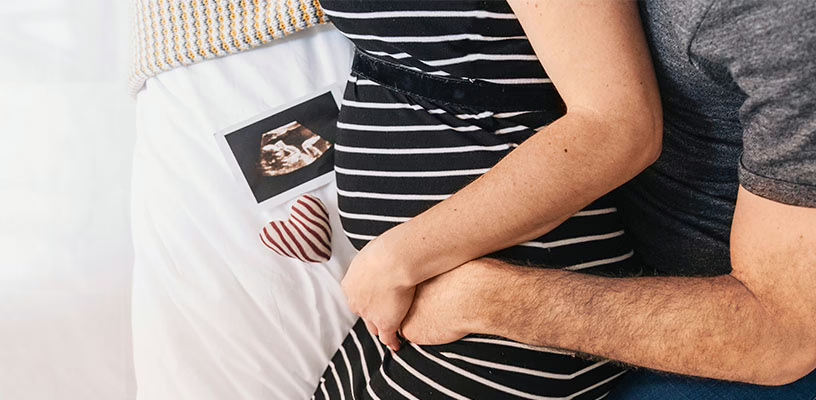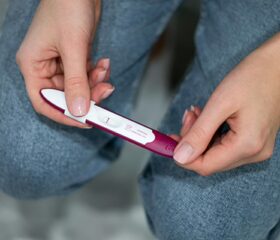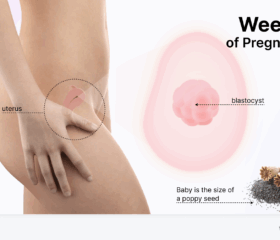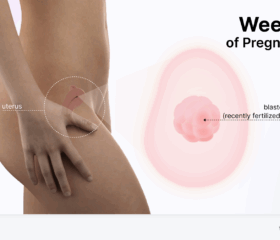When Do You Start Showing in Pregnancy?
There will come a time when your belly will announce that you’re pregnant, and it might happen sooner than you expect.

The exact time your baby bump will decide to “show” won’t necessarily be the same as it was for other pregnant women you might know. It can even change from pregnancy to pregnancy.
That said, it’s still possible to guess roughly when you can expect your baby to make his presence known. Read to learn when that is and what factors will affect the timing (plus some tips for managing your bump).
How early can your baby bump show?
If this is your first pregnancy, your baby bump might show as early as week 12. That’s usually when your uterus grows too big for your pelvis and moves up, into your abdomen. 1
Many first-time moms start showing sometime between weeks 12 and 16, although it’s possible to show earlier or later than that. 2 There isn’t a “normal” gestational age for when your baby bump should show and grow, so don’t compare yourself with your fellow moms-to-be.
What factors affect when your baby bump will show?
One of the main factors that affects when you start to show is whether this is your first pregnancy or not. If you’ve been pregnant before, you may show sooner this time around. It’s easier for your uterus to expand since your abdominal and uterine muscles have already been stretched.
Other factors that can influence when your baby bump will show include:
- Body type: Your baby bump may show earlier if you’re shorter and have a smaller frame. By contrast, taller or plus-size women’s baby bumps often show later.
- Core muscle strength: By and large, women with weaker core muscles will show sooner, while those with stronger core muscles will show later. That’s one reason why many older women have noticeable bumps earlier in their pregnancies.
- Uterine position: The position of your uterus—whether it tilts forward (i.e., it’s anteverted) or backward (retroverted)—can also play a role. You’ll likely show earlier with an anteverted uterus and later if you’re pregnant with a retroverted uterus.
- Multiple pregnancies: If you’re carrying more than one baby, you’ll probably show sooner than someone with a single pregnancy. 2
- Uterine conditions: Certain conditions, like uterine fibroids (tumors that are typically benign), can make your uterus grow larger and cause your bump to show sooner. 3
How your baby bump will change throughout the trimesters
As you know, your baby bump will grow as your pregnancy progresses. Here’s what you can expect during each trimester:
First trimester (weeks 1–12)
At this stage, your uterus is still in its usual spot in your pelvis. You might notice that your abdomen is a bit bloated, but even though that may lead to your clothes feeling tight, that isn’t the same as having a baby bump. 1
Second trimester (weeks 13–28)
As mentioned, your uterus will rise at about week 12. Around week 16–17, it may reach the bottom of your belly button. Your baby bump will become more noticeable then.
As mentioned, by the time you reach the middle of the second trimester, you may be showing enough for other people to notice your pregnancy (not just you).
By the end of your second trimester, you might see your belly button “pop,” transforming from an innie to an outie (assuming you weren’t in the outie club already). If this change is unwelcome, don’t worry—your pregnant belly button will probably return to normal a few weeks or months after you give birth.
Third trimester (weeks 29–40)
Your baby will grow rapidly during the third trimester, and so will your bump. By your 36th week, your baby may have dropped down into your pelvic area. This is known as “lightening,” and will make it easier to breathe since he won’t be pressing on your organs as much. 4
How to tell bloating from a baby bump
If your abdomen feels large in the early stages of your pregnancy, it’s probably not your baby bump. Pregnancy hormones can cause your gastrointestinal tract (digestive tract) to “relax” or slow down.
This, in turn, can lead to several infamous pregnancy symptoms, including bloating, constipation, diarrhea, indigestion, and heartburn. 5
If you aren’t sure whether your baby bump is showing or you’re just a bit bloated, it’s probably the latter, but give it time. As your uterus grows, you’ll notice a firmer, more obvious bump that isn’t just related to your digestive issues.
How to ease the symptoms of bloating
Pregnancy-related digestive issues aren’t fun. You can make yourself feel better by drinking more water, having smaller, more frequent meals, eating a high-fiber pregnancy diet, and steering clear of certain foods.
Read up on the list of foods to avoid in pregnancy, and be cautious with ones that are high in insoluble fiber (which causes gas), such as beans and lentils.
What should you do if you’re not showing as expected?
You don’t have to worry if you aren’t showing as early as you expected. With so many factors affecting your baby bump’s growth, it’s hard to say when it’ll finally appear.
Showing later doesn’t automatically mean there’s something wrong with your baby’s growth or pregnancy. You don’t need to see a doctor unless you have other concerning symptoms, such as bleeding or severe abdominal pain. Just remember to go to your prenatal care checkups.
How your doctor will monitor your bump
When your baby bump shows, your doctor will measure your fundal height (the length between your pubic bone and the top of your uterus) to track your baby’s growth. 6
If the measurements are off from where they’re “supposed” to be, your doctor may order further testing to rule out potential issues. 7
Tips for managing your baby bump
It can take some time to get used to having a baby bump. After all, your body is adjusting to a lot of changes. You can ease your discomfort with a few simple tips:
Wear maternity clothes
It’s up to you when you should start wearing maternity clothes, but wearing clothes that fit well can help you feel more confident and comfortable in your body.
If you’re not ready to announce your pregnancy, they don’t have to actually be from the maternity section of the clothing store. Just wear loose-fitting clothes like flowy dresses, blouses, and sweaters to hide your bump. When you’re ready to show it off, you can switch to form-fitting maternity clothes.
Don’t compare yourself to other moms
If you haven’t started showing yet, don’t be dismayed. Avoid comparing your pregnancy with what you’re seeing from other moms, especially people on social media.
Watching other people’s baby bumps grow faster can get stressful. Focus on your own progress and follow your doctor’s tips for a healthy pregnancy.
Final thoughts
While it’s possible to guess roughly when you’ll see your baby bump, there are no guarantees, and pregnancy doesn’t progress according to a fixed timeline. Your bump will show when it’s ready.
In the meantime, take care of yourself. As long as you’re feeling good and your doctor says you and your baby are healthy, you’re on the right track.
Article Sources
- Cedars-Sinai. "Pregnancy" Retrieved May 7, 2025.
- Brigham and Women's Hospital. "FAQs About Pregnancy with Twins, Triplets and More" Retrieved May 7, 2025.
- MedlinePlus. "Uterine fibroids" Retrieved May 7, 2025.
- Johns Hopkins Medicine. "The Third Trimester" Retrieved May 7, 2025.
- Utah Department of Health & Human Services. "Discomforts of Pregnancy" Retrieved May 7, 2025.
- Eunice Kennedy Shriver National Institute of Child Health and Human Development. "What happens during prenatal visits?" Retrieved May 7, 2025.
- MedlinePlus. "Intrauterine growth restriction" Retrieved May 7, 2025.







